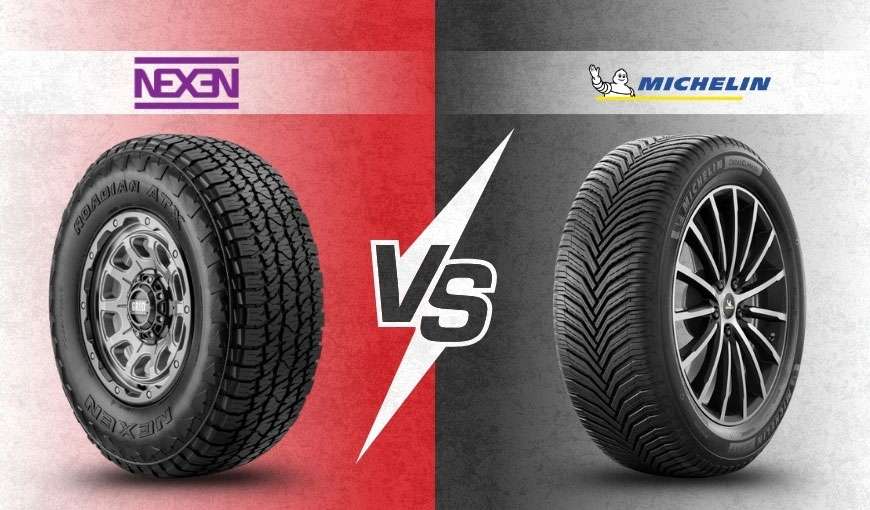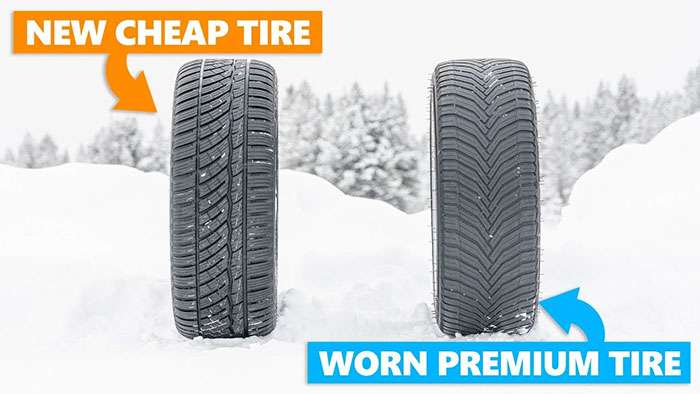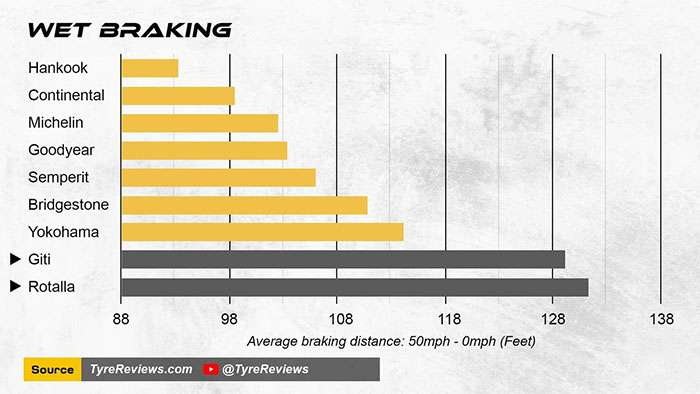
Finding the best low price tires seems straightforward until you discover the startling reality. More than two million MOT failures occur each year due to defective tires, with half deemed 'dangerous' according to a 2024 TyreSafe report. Budget tires certainly appear attractive with their $200 to $400 price tags compared to premium options that cost $800 or more. The question is: are you actually saving money?
We understand that tire purchasing decisions impact both your safety and your budget. When comparing cheap vs expensive tires, the initial price difference tells only part of the story. Premium tires deliver measurable advantages including superior braking distances, enhanced grip, and engineered tread patterns for reliable all-weather performance. Testing reveals that premium tires stop a vehicle over 7 meters shorter from 80 km/h in wet conditions than the best budget tire.
Budget tires may look like smart savings upfront, but they often cost more over time due to faster wear rates. Are expensive tires worth it? Premium tires require a higher initial investment, yet their enhanced durability and superior construction typically provide more miles before replacement becomes necessary. This translates to better long-term value through fewer tire changes and potential fuel savings.
At Performance Plus Tire, we believe in helping you make informed decisions based on real performance data and total cost analysis. This guide examines which tire option actually saves you money in 2025 when you consider all the factors that matter.

Image Source: YouTube
The differences between budget and premium tires go far deeper than price tags. Understanding these distinctions explains why performance and safety vary dramatically between categories.
Manufacturing quality creates the foundation of tire performance differences. Premium tires utilize sophisticated blends of natural and synthetic rubbers, silica, and advanced polymers that optimize grip, wear resistance, and fuel efficiency. These high-grade materials integrate with reinforced internal structures including stronger belts and sidewalls that enhance stability and damage resistance.
Budget tires employ basic rubber compounds and simpler construction techniques to keep costs down. This fundamental materials difference directly impacts durability, as budget options use less durable rubber compounds that wear faster. Premium tire manufacturers invest heavily in research and development, incorporating noise-reducing technologies and specialized features that budget brands simply cannot match.
Premium tires showcase meticulously engineered tread patterns optimized for specific performance characteristics. These advanced designs improve water evacuation, reducing hydroplaning risk in wet conditions. Premium tread patterns often incorporate noise-reducing elements, such as variable-pitch designs and specialized block arrangements.
Budget tires utilize simpler tread designs that may not prioritize even wear or long-term performance. Their shallower tread depth leads to faster wear, reduced traction, and shorter lifespan. While budget treads provide basic road contact, they lack the engineering refinements that make premium tires excel in challenging conditions.
Specific brand comparisons illustrate these differences clearly. Zeetex represents quality budget options, using silica-rich compounds and steel belts that deliver decent performance for everyday driving. However, direct comparisons with premium brands reveal clear limitations.
When tested against Michelin's Alpin 6, Zeetex's WH 1000 showed notable performance gaps. The Michelin tire achieved significantly better wet braking performance, stopping at 36.2 meters compared to Zeetex's 42.3 meters. Additionally, extensive testing showed Michelin receiving "Good" ratings across categories while Zeetex earned mostly "Sufficient" marks.
This real-world comparison demonstrates how premium tires like Michelin—with their century-plus heritage of innovation and extensive R&D investment—deliver measurably superior performance. While premium options require greater initial investment, their enhanced engineering and materials quality translate to tangible performance advantages that budget alternatives cannot match.

Image Source: Tire Crunch
Safety testing reveals dramatic differences between premium and budget tires that directly impact driver protection. The performance gaps become most apparent during emergency stops and challenging driving conditions.
Wet braking performance shows the most critical safety difference between tire categories. Continental premium tires come to a complete stop 8.1 meters before the average budget tire. Even more alarming, when a Continental tire has fully stopped, testing showed the worst budget tire tested was still traveling at 49 km/h.
The numbers tell a stark story. Budget tires required up to 18 meters more distance to stop completely from 50 mph. That's more than three car lengths of additional stopping distance - potentially the difference between avoiding a collision and a serious accident.
Best budget tires provide adequate grip for everyday urban driving in dry conditions. Premium options deliver enhanced precision during evasive maneuvers and higher-speed driving situations.
Testing reveals measurable handling differences. Budget tires required a speed reduction of 3.11 mph to match premium tire handling on wet roads. The advanced compounds in premium tires create better traction during cornering and acceleration, resulting in more responsive vehicle control.
Aquaplaning occurs when tires lose road contact due to water buildup. Premium tires excel at water evacuation through advanced tread engineering.
The testing data is clear: Continental premium tires maintain traction until 80.9 km/h versus budget options that begin to float at much lower speeds. During heavy rain, cheap tires lose road contact earlier, reducing steering effectiveness when you need it most.
Curved aquaplaning resistance shows similar disparities. Premium Continental tires maintained 6.31 m/sec² of lateral acceleration in curved water tests compared to budget options at just 5.21 m/sec². This translates to substantially better control when navigating wet corners.
When evaluating are expensive tires worth it, these performance differences highlight why the initial investment often pays dividends in critical safety situations.
Tire selection affects more than just safety - it impacts your fuel costs with every mile you drive. The difference between budget and premium options extends to how efficiently your vehicle operates, creating ongoing savings or expenses that many drivers overlook.
Rolling resistance determines how much energy your engine burns to keep your tires moving. Think of it like pedaling a bicycle with underinflated tires - your engine works harder to maintain the same speed. Lower resistance means better fuel economy and more money in your pocket.
Testing reveals significant differences between tire options. The budget Maxtrek MAXIMUS M1 measured rolling resistance of 9.82 kg/t, while the more efficient Tomket Sport Series 1 registered just 8.28 kg/t. Interestingly, the premium Continental PremiumContact 7 measured 8.38 kg/t, showing that efficiency doesn't always correlate directly with price.
Low-rolling resistance tires typically improve fuel economy by 1% to 4% compared to standard options. While that might sound modest, the savings accumulate over thousands of miles. Drivers of typical sedans could save roughly $30 annually by choosing more efficient tires.
For high-mileage drivers covering 20,000 miles annually, these efficiency gains become particularly meaningful. The fuel savings alone can offset a portion of the tire investment, especially when combined with longer tread life.
Here's what many drivers don't realize: proper tire inflation affects fuel efficiency more than tire quality. Even premium tires perform poorly when underinflated. The U.S. Department of Energy reports that fuel economy drops approximately 0.2% for every 1 PSI below recommended pressure.
The impact becomes dramatic with severely underinflated tires. At just 50% of recommended pressure, fuel economy can drop 10% at lower speeds and 5% at highway speeds. Conversely, maintaining proper inflation can improve gas mileage by 0.6% to 3%.
Cold weather creates additional challenges as temperatures cause pressure drops that require more frequent checking. Regular maintenance - including proper inflation, alignment checks, and tire rotation - ensures optimal efficiency regardless of whether you choose budget or premium tires.
At Performance Plus Tire, we recommend checking tire pressure monthly and before long trips. This simple habit maximizes fuel efficiency and extends tire life, delivering benefits no matter which tires you select.
The sticker price tells only part of the tire story. Real value becomes clear after thousands of miles when you calculate the total cost of ownership.
The longevity difference between budget and premium tires is striking. Consumer Reports' extensive testing shows that high-quality premium tires regularly achieve 70,000 to 85,000 miles, with two top-rated Michelin models projecting to 85,000 miles of tread life. Many budget options wear out after just 20,000 to 30,000 miles. During the time one set of premium tires remains serviceable, you might replace budget tires twice or even three times.
Tire construction directly impacts durability. Premium tires utilize higher-grade compounds specifically engineered to withstand daily driving stresses, offering enhanced resistance to wear and damage. Proper maintenance extends tire life regardless of category—regular rotation, alignment checks, and maintaining correct pressure can maximize lifespan for any tire.
The math changes dramatically when you examine cost per mile driven. Budget tires priced at $400 that last 30,000 miles cost approximately 1.3 cents per mile. Premium tires at $800 lasting 70,000 miles cost about 1.1 cents per mile.
The total ownership calculation often favors premium options. While best low price tires provide immediate savings, their shorter lifespan typically results in more frequent replacements, ultimately increasing long-term expenses. Premium tires may yield additional savings through improved fuel efficiency and reduced maintenance requirements.
Warranty protection represents another crucial cost factor. Premium tire manufacturers typically offer treadwear warranties guaranteeing 40,000 to 80,000 miles. These warranties often include road hazard protection and free replacements for manufacturing defects.
Many budget brands provide limited coverage—sometimes just manufacturing defects for a short period. This difference becomes significant if problems arise. A warranty that expires at 30,000 miles on a tire rated for 70,000 miles leaves you unprotected during most of the tire's expected lifespan. For drivers questioning "are expensive tires worth it," this protection adds substantial value beyond tread longevity.
Your specific driving patterns determine which tire option delivers the best value for your situation. Understanding your typical usage helps identify whether budget or premium tires make financial sense.
City roads create unique challenges for tires. Frequent stops, starts, and tight turns accelerate tread wear, while potholes and curb impacts demand stronger sidewalls. Highway driving maintains steadier speeds on better-maintained surfaces, creating less stress on tire components.
Urban drivers benefit from tires built to withstand harsh conditions and impacts. Highway-focused drivers should prioritize tires designed for sustained speeds that resist heat buildup during long stretches.
Drivers covering limited distances may find best budget tires perfectly adequate for their needs. High-mileage drivers require different considerations. When you frequently travel long distances, premium options typically deliver better cost-per-mile value through extended lifespan. High-performance vehicles with higher torque benefit most from premium tires regardless of driving frequency.
Climate plays a crucial role in tire selection. Temperatures below 44°F require winter tires as standard rubber compounds harden and lose effectiveness. The performance difference is dramatic—a vehicle traveling 31 mph needs 52 yards to stop with summer tires on snow compared to just 26 yards with proper winter tires.
Budget tires work well for drivers who primarily travel short distances in moderate weather conditions. Those facing challenging weather, operating high-performance vehicles, or accumulating significant annual mileage typically find premium tires offer better long-term value.
The key lies in matching your tire investment to your actual driving demands and safety requirements.
Understanding the differences between budget and premium tires becomes clearer when you examine the key specifications side by side. We've compiled the most important performance and cost factors to help you make an informed decision.
| Characteristic | Budget Tires | Premium Tires |
|---|---|---|
| Initial Cost | $200-400 per set | $800+ per set |
| Tread Life | 20,000-30,000 miles | 70,000-85,000 miles |
| Wet Braking Distance (from 50 mph) | 46m | 31.5m |
| Rolling Resistance | 9.82 kg/t (Maxtrek MAXIMUS M1) | 8.38 kg/t (Continental PremiumContact 7) |
| Warranty Coverage | Limited coverage, short period | 40,000-80,000 miles with road hazard protection |
| Cost Per Mile | 1.3 cents | 1.1 cents |
| Construction Materials | Basic rubber compounds, simpler construction | Advanced rubber blends, silica, specialized polymers |
| Tread Design | Simple patterns, shallower depth | Engineered patterns, noise-reducing elements |
| Aquaplaning Resistance | Lower speed threshold | Maintains traction up to 80.9 km/h |
| Fuel Efficiency Impact | Lower efficiency | 1-4% better fuel economy |
The numbers tell a clear story. While premium tires cost more upfront, they deliver superior performance in every measurable category that affects your safety and long-term costs.
The numbers don't lie when it comes to tire value. While budget tires attract drivers with their $200-400 price tags, the real savings come from understanding total cost of ownership. Premium tires deliver where it matters most: safety, longevity, and actual cost per mile.
Consider the safety factor alone. That 15-meter difference in wet braking could mean avoiding a collision entirely. When you add the extended lifespan—often triple that of budget options—premium tires become the smarter financial choice for most drivers.
At Performance Plus Tire, we've seen countless customers discover this reality. The driver who chooses premium tires typically enjoys better performance, enhanced safety, and lower long-term costs. They're not just buying tires; they're investing in peace of mind and genuine value.
Budget tires have their place. If you drive fewer than 8,000 miles annually in mild weather conditions, or if you're planning to sell your vehicle within two years, budget options can serve your needs adequately.
For everyone else—especially high-mileage drivers facing varied weather conditions—premium tires represent the better investment. The enhanced durability, superior safety performance, and improved fuel efficiency create measurable value that budget alternatives simply cannot match.
Ready to make the smart choice for your vehicle? Our tire experts are available to help you find the perfect tires for your driving needs and budget. Whether you're looking for maximum performance or the best value in budget options, we carry the selection and expertise to keep you safe on the road.
Visit Performance Plus Tire today and discover why investing in quality tires is one of the smartest decisions you can make for your vehicle.
When choosing between budget and premium tires, the long-term financial picture often favors higher-quality options despite their steeper upfront costs.
• Premium tires stop 15 meters shorter in wet conditions and last 2-3 times longer than budget options, making them safer and more cost-effective per mile driven.
• Budget tires cost 1.3 cents per mile versus premium at 1.1 cents per mile, with premium options offering better fuel efficiency and comprehensive warranty coverage.
• Choose budget tires only if you drive infrequently in mild conditions; high-mileage drivers save money long-term with premium tires despite higher initial investment.
• Safety performance gaps are significant: premium tires maintain traction until 80.9 km/h in wet conditions while budget options lose grip much earlier.
The math is clear—while budget tires appear cheaper initially, premium tires typically deliver superior value through enhanced safety, longer lifespan, better fuel economy, and lower total cost of ownership over time.
While premium tires have a higher upfront cost, they often provide better value over time. They typically last 2-3 times longer than budget tires, offer superior safety performance, and can improve fuel efficiency. For most drivers, especially those covering high mileage, the long-term savings and enhanced safety make premium tires a worthwhile investment.
There's a significant difference in wet braking performance between budget and premium tires. Premium tires can stop up to 15 meters shorter from 50 mph in wet conditions compared to budget options. This improved stopping distance can be crucial for avoiding accidents in challenging weather.
Yes, budget tires typically wear out much faster than premium tires. While budget tires may last around 20,000 to 30,000 miles, high-quality premium tires can often achieve 70,000 to 85,000 miles of tread life. This means you might need to replace budget tires two or three times during the lifespan of one set of premium tires.
Tire selection can have a noticeable impact on fuel efficiency. Premium tires often feature lower rolling resistance, which can improve fuel economy by 1% to 4% compared to standard options. Over thousands of miles, this can lead to significant fuel savings, especially for high-mileage drivers.
Budget tires can be a suitable option for drivers who cover limited distances in moderate weather conditions or those planning to sell their vehicle soon. They're also appropriate for occasional drivers who don't require high-performance characteristics. However, for most regular drivers, especially those facing challenging weather or accumulating significant mileage, premium tires often represent a better long-term investment.